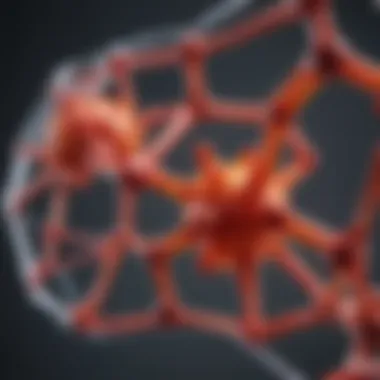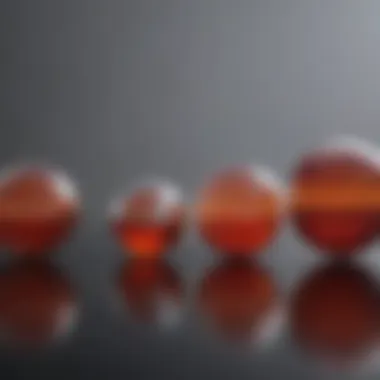Exploring Ethylene Vinyl Acetate Copolymer: Properties and Uses


Intro
Ethylene vinyl acetate copolymer, commonly referred to as EVA, has gained significant attention in various sectors due to its unique properties and wide-ranging applications. As a copolymer formed from ethylene and vinyl acetate, EVA displays remarkable flexibility, durability, and clarity. Its diverse physicochemical characteristics allow it to be utilized in industries like packaging, automotive, healthcare, and consumer goods. In recent years, the focus on environmentally friendly materials has increased interest in EVA and its potential for innovative applications.
Key Concepts and Terminology
Definition of Key Terms
To understand the significance of EVA, it is vital to define some key terms related to this material:
- Copolymer: A polymer derived from more than one species of monomer. EVA is a copolymer of two monomers: ethylene and vinyl acetate.
- Thermoplastic: A type of plastic that becomes pliable or moldable upon heating. EVA belongs to this category, which contributes to its versatility in applications.
- Mechanical Properties: Refers to the material's behavior under various conditions, including tensile strength, hardness, and elasticity.
- Photostability: The ability of a material to resist deterioration caused by exposure to light, particularly ultraviolet radiation.
Concepts Explored in the Article
This article delves into various aspects related to EVA:
- Production Methods: How EVA is synthesized and processed, discussing the methods involved and their implications on the final properties of the material.
- Mechanical Characteristics: Insights into the physical properties of EVA that make it suitable for distinct applications.
- Environmental Impact: Evaluating how the production and disposal of EVA influence the environment, alongside potential sustainable practices.
- Emerging Applications: Highlighting innovative uses of EVA that showcase its versatility and adaptability in new markets.
Findings and Discussion
Main Findings
The analysis reveals that EVA offers several essential advantages across its applications. Its flexibility and transparency make it ideal for packaging, particularly in food preservation. The presence of vinyl acetate enhances adhesion properties, making EVA useful in adhesives and sealants. Furthermore, EVA’s resistance to UV radiation makes it favorable for outdoor products.
Potential Areas for Future Research
There are several areas where further research can provide insights into the uses and properties of EVA:
- Biodegradable Alternatives: Investigation into how EVA can be blended with biodegradable materials to reduce environmental impact.
- Novel Processing Techniques: Exploring advanced production methods that could enhance EVA's mechanical properties or reduce manufacturing costs.
- Nanotechnology Applications: Evaluating how incorporating nanoscale materials could expand EVA's range of applications in industries like medicine and electronics.
"Understanding the fundamental properties of ethylene vinyl acetate copolymer gives professionals the knowledge to innovate and utilize this material effectively across various fields."
Understanding Ethylene Vinyl Acetate Copolymer
Ethylene Vinyl Acetate Copolymer, commonly known as EVA, is a widely recognized material in various industries today. Understanding its characteristics provides insight into why it has become essential. Its applications range from packaging to medical devices, illustrating its versatility. Therefore, comprehending EVA begins with recognizing its chemical structure and how it is formed.
Chemical Structure of EVA
The chemical structure of EVA consists of two primary components: ethylene and vinyl acetate. These two components copolymerize to create a material that has unique properties. The ratio of ethylene to vinyl acetate can be altered to meet specific requirements, resulting in variations in the polymer's characteristics. Typically, EVA contains around 10% to 40% vinyl acetate. This composition affects properties such as flexibility and adhesive strength.
The repeating units in the polymer chain significantly influence how the material performs under stress. A higher percentage of vinyl acetate often results in greater flexibility and toughness. This structural variability is what makes EVA adaptable for numerous applications, confirming its relevance in today’s material sciences.
Mechanism of Polymerization
The production of EVA involves a process known as copolymerization. This is where the two distinct monomers - ethylene and vinyl acetate - are combined to create the copolymer. Generally, common methods include two methods: high-pressure and low-pressure polymerization techniques.
During high-pressure polymerization, gas-phase ethylene is subjected to high pressure in the presence of a radical initiator. Here, the ethylene molecules add to the growing polymer chain, while the vinyl acetate contributes to the copolymer's side chains. This enables the formation of a stable, interlinked polymer network. Conversely, low-pressure techniques offer better control over molecular weight and allow for a more precise adjustment of the EVA composition.
Variations in Composition
The composition of EVA is not fixed. Instead, it varies to cater to specific industrial needs. Modifications can be made to the ratios of ethylene and vinyl acetate to enhance particular characteristics. For instance, increasing the vinyl acetate content can improve the material's clarity and adhesion properties, making it favorable for packaging applications. Conversely, a higher ethylene content can enhance thermal stability and impact resistance.
Other variations include the incorporation of additives like antioxidants or UV stabilizers, which improve EVA's durability and performance in harsh environments. The ability to tailor EVA to meet specific requirements shows its adaptability and adds to its broad spectrum of applications in various fields.
Properties of Ethylene Vinyl Acetate Copolymer
The properties of Ethylene Vinyl Acetate Copolymer (EVA) play a crucial role in its diverse applications. Understanding these properties allows for better utilization in various industries. EVA's unique combination of physical and chemical properties makes it suitable for multiple uses, from packaging to medical devices. The following sections will dissect these properties to highlight their importance and relevance.
Physical Properties


Density
Density is a significant factor in the performance of EVA. It defines material's weight in relation to its volume, influencing its efficiency in applications. EVA typically has a lower density compared to other polymers, which allows designers to create lightweight structures without compromising durability. The low density is a beneficial attribute, making it a popular choice in flexible packaging, insulation, and footwear. Moreover, it aids in reducing the overall product weight, enhancing usability and comfort.
Thermal Stability
Thermal stability refers to the ability of EVA to maintain its properties under high temperatures. This is a key characteristic because many applications involve heat. EVA exhibits good thermal stability, preventing degradation in various environments. Its ability to withstand heat expands its application range, especially in materials exposed to changing temperature conditions. However, it is essential to note that while EVA is thermally stable, it may not perform well in extremely high-temperature situations.
Flexibility and Elasticity
Flexibility and elasticity are defining features of EVA. These properties make it a highly adaptable material. The flexibility allows EVA to be easily shaped and formed during the manufacturing process. Its elasticity enables it to return to its original shape after deformation. This characteristic is especially important in industries such as footwear, where comfort and support are paramount. EVA’s combination of flexibility and elasticity ensures that products made from this polymer can withstand daily wear and tear, making it a favorable material in various applications.
Chemical Properties
Resistance to Solvents
Resistance to solvents is another vital property of EVA. This characteristic determines how EVA interacts with different chemicals and environments. EVA demonstrates notable resistance to a wide variety of solvents, which makes it ideal for applications where exposure to harsh substances is expected. This resistance enhances the longevity and reliability of products made from EVA—in particular, those used in packaging and medical devices. However, it is crucial to identify specific solvents that may cause attacks on EVA, as not all formulations perform equally well.
UV Stability
UV stability indicates how well a material can withstand ultraviolet radiation. EVA has fairly good UV resistance, making it suitable for applications in outdoor settings or where light exposure is constant. This property is significant as it helps prevent material degradation when exposed to sunlight over time. Enhanced UV stability means that products maintain their structural integrity and appearance, thereby increasing their lifespan. Nonetheless, prolonged exposure can still lead to some degradation, necessitating periodic evaluations of products in UV-rich environments.
Adhesion Characteristics
Adhesion characteristics of EVA are essential for applications requiring effective bonding. EVA can easily adhere to various surfaces, making it a favored choice for adhesives in both packaging and construction industries. The unique feature of EVA’s adhesion is its compatibility with different materials, enhancing its versatility. Its strong bonding capabilities allow for effective sealing and joining in multiple contexts. However, challenges may arise when used with certain plastics or high-energy surfaces; thus, evaluating compatibility is crucial.
EVA's properties render it a versatile and efficient material across numerous applications, balancing performance with practicality.
Production Methods of Ethylene Vinyl Acetate Copolymer
The production methods of Ethylene Vinyl Acetate copolymer (EVA) are crucial to its properties and applications. Each method influences the material’s characteristics, such as molecular weight, viscosity, and overall performance. Understanding these methods helps manufacturers optimize the production process to meet specific requirements in various industries.
Batch Polymerization
Batch polymerization is a traditional and widely used method for producing EVA. In this process, all ingredients are combined in a reactor, and the reaction occurs in batches. The main advantage of batch polymerization lies in its flexibility. It allows for easy control of reaction conditions, such as temperature and pressure, which are essential for achieving desired product qualities.
The quality of the final product can be directly managed by altering factors like time and temperature. An aspect to consider is the production time, which can be longer compared to continuous methods.
Important points:
- Best for small quantities or specialized formulations.
- Higher control over reaction parameters.
- Suitable for producing different grades of EVA.
Continuous Polymerization
Continuous polymerization is a more modern technique and is often favored in large-scale production of EVA. In this method, reactants are fed continuously into a reactor, which allows for a steady output of copolymer material. This approach is more efficient than batch polymerization for large-scale applications, reducing production time considerably.
Continuous polymerization also tends to offer higher productivity and lower labor costs. However, it requires a more significant initial investment in equipment.
Key features include:
- Suitable for large volumes.
- Better overall efficiency and lower costs in production.
- Requires advanced equipment and technology.
Emulsion and Suspension Polymerization
Emulsion and suspension polymerization are two similar techniques employed in the production of EVA. Both methods involve the dispersion of the reactants in water, resulting in various size particles of EVA resins.
Emulsion polymerization typically provides smaller particle sizes, making it a preferable choice for applications requiring fine materials. Conversely, suspension polymerization yields larger particles and can lead to improved processing ease.
Here’s an overview:


- Emulsion Polymerization: Produces fine particles, ideal for coatings and adhesives.
- Suspension Polymerization: Generates larger particles, beneficial for uses like packaging films.
Both methods allow for the integration of various additives during production. This flexibility leads to the enhancement of specific properties, such as improved adhesion and thermal stability, which are essential in diverse applications.
Understanding these production methods is key for industries utilizing EVA. Each technique offers unique benefits that can align with specific needs.
Applications of Ethylene Vinyl Acetate Copolymer
The applications of ethylene vinyl acetate copolymer (EVA) are extensive and diverse, making it an important subject in this article. EVA is valued in multiple industries due to its unique properties such as flexibility, transparency, and resistance to UV radiation. Its versatility allows it to be used across different fields, making it both an innovative and practical choice. Understanding these applications can provide insights into the material's significance and potential impact on various sectors.
In Packaging Industry
Flexible Packaging Films
Flexible packaging films made with EVA are crucial in the packaging industry. These films offer excellent barrier properties that help protect contents from moisture and oxygen. This characteric makes them popular for food packaging as they enhance shelf life. Their flexibility allows them to conform to different shapes, which is essential for creating user-friendly packaging. A unique feature of flexible packaging films is their ability to seal easily, which prevents leakage and spoilage of products. The main advantage is the reduction in waste and the ability to maintain product quality. However, the downside could be that not all films are suitable for high-temperature applications.
Adhesives for Labels
EVA adhesives are frequently used for labels. They provide strong adhesion properties that ensure labels stay attached even in challenging conditions. Their ability to bond well with various substrates makes them a popular choice among manufacturers. One key characteristic of EVA-based adhesives is their quick drying time, which enhances production efficiency. This unique feature allows for faster assembly lines, which is critical in high-volume production environments. The main advantage is improved productivity, but the disadvantage could be the potential for brittle adhesion over time in certain environmental conditions.
In Footwear Manufacturing
Shoe Soles
In footwear manufacturing, EVA is frequently used in the production of shoe soles. Its lightweight nature and inherent flexibility are desirable qualities for comfort and performance. This unique characteristic allows for cushioning, which enhances user experience during wear. One significant advantage is the shock absorption properties, making them suitable for athletic shoes. However, the potential downside is that not all EVA formulations offer the same level of durability against wear and tear over long periods.
Comfort Layering
Comfort layering in shoes often utilizes EVA to provide additional cushioning and support. This application enhances the wearer's comfort by distributing weight evenly across the foot. A key feature of this layering technique is its ability to retain shape over time, contributing to long-lasting comfort. This is especially beneficial for individuals who are on their feet for extended periods. The main advantage here is the improved ergonomics of footwear, though care must be taken with production methods to ensure consistent quality.
In Medical Devices
Drug Delivery Systems
In the medical field, EVA is gaining traction for drug delivery systems. Its biocompatibility is a key reason for its use, as it minimizes the risk of adverse reactions in patients. One significant benefit of using EVA is its flexibility, which allows for the design of systems that can adapt to different delivery methods. This unique feature lends itself well to innovations in medical device technology. However, its application in drug delivery may face challenges related to the drugs' stability when in contact with EVA over time.
Catheters and Tubing
EVA is also used in catheters and tubing due to its excellent clarity and flexibility. These characteristics improve visibility, which is crucial for medical professionals during procedures. Additionally, EVA's resistance to kinking ensures reliable flow rates of fluids. A unique feature of EVA in this context is its ease of sterilization, which is necessary for medical applications. The main advantage is enhanced patient safety and comfort, but it may not always be suitable for high-pressure applications.
Environmental Considerations
Understanding the environmental implications of Ethylene Vinyl Acetate Copolymer (EVA) is crucial in today’s eco-conscious climate. The widespread use of EVA in various sectors necessitates an examination of its biodegradability, recycling capabilities, and overall life cycle impact. This awareness allows industries and consumers to make informed decisions about the use and disposal of this material, aligning with sustainable practices.
Biodegradability Challenges
Biodegradability remains one of the significant challenges associated with EVA. While EVA is recognized for its durability and resistance to environmental factors, these traits also mean that it does not break down easily in nature. Unlike some biodegradable materials, EVA can persist in landfills for many years, contributing to plastic pollution if not managed properly. This long degradation period brings to light the need for enhanced materials or additives that could improve its biodegradability without compromising performance. Researchers are exploring several pathways, such as incorporating natural substances or designing enzymatically active compounds that may aid in the breakdown process.
Recycling Potential
Recycling EVA is feasible but not as widely practiced as with some other polymers. The primary reason is the challenges involved in separating it from other materials, which complicates the recycling process. However, EVA can be recycled through specific systems that reclaim the material and repurpose it for various applications. Initiatives are underway to improve the efficiency of these systems, demonstrating potential for closing the loop on EVA usage in industries like packaging and footwear manufacturing. Indeed, developing better technologies to recycle EVA can reduce waste and promote more sustainable practices within those sectors.
Life Cycle Assessment
Life cycle assessment (LCA) is a fundamental approach to evaluate the overall environmental impact of EVA throughout its life cycle, from production to disposal. This assessment helps in identifying energy consumption, emissions, and resource depletion associated with EVA. The findings from LCAs can provide valuable insights for manufacturers aiming to minimize their ecological footprint. They can highlight stages in the production or disposal processes where improvements could be made. Effective LCA methodologies can guide companies in the transition to more sustainable operations and better product designs, making a substantial impact on environmental conservation efforts.
"Understanding the life cycle of EVA not only informs manufacturers about its environmental impact but also drives innovation towards greener alternatives."
By acknowledging these environmental considerations, industries can take essential steps toward a more sustainable future. This awareness promotes research collaborations aimed at improving EVA's ecological profile and aligns development efforts with global sustainability goals.


Innovations in Ethylene Vinyl Acetate Copolymer Research
Innovations in the research of Ethylene Vinyl Acetate Copolymer (EVA) highlight the adaptability and potential of this material in various applications. The advancements in EVA research focus on enhancing its properties, which directly affects its performance across industries. Understanding these innovations allows for better integration of EVA into existing systems and encourages exploration of new markets. As technology evolves, it becomes crucial to identify the specific benefits arising from these developments, which can lead to more sustainable practices and improved product performance.
Advanced Compounding Techniques
Recent advancements in compounding techniques have significantly influenced the properties of EVA. Compounding involves blending EVA with various fillers, plasticizers, and additives to achieve desired characteristics. Techniques such as melt blending and solution blending have become popular. These methods enable precise control over the composition and distribution of additives, which improves the final product's performance. For instance, functional fillers can enhance thermal stability and UV resistance, making EVA suitable for more demanding applications.
"The integration of new compounding technologies not only uplifts EVA’s physical properties but also broadens its potential usage across multiple sectors, including automotive and biomedical."
The use of advanced compounding techniques can also reduce production costs. By optimizing the materials used and the techniques applied, manufacturers can produce higher quality EVA products while minimizing waste. This is particularly relevant when considering the environmental footprint of production processes.
New Blending Opportunities
The exploration of new blending opportunities has resulted in unique EVA formulations. By blending EVA with other polymers, researchers are finding ways to enhance its properties further. These blends can deliver superior flexibility, impact resistance, and thermal stability compared to standard EVA. Such enhancements open avenues for EVA in applications that require specific performance criteria, such as high-performance coatings and specialized seals.
Integrating EVA with materials like thermoplastic polyurethane or ethylene propylene diene monomer (EPDM) can yield blends with exceptional durability and elasticity. The combination not only targets improved performance metrics but also aims to fulfill regulatory and consumer demands for more sustainable products.
Functionalization Approaches
Functionalization approaches have gained attention in EVA research, aiming to modify the copolymer's properties for specialized applications. This involves introducing functional groups into the EVA structure, thereby enhancing its adhesion, compatibility, and overall performance in specific environments. For instance, by incorporating hydrophilic groups, researchers can create EVA variants that have better moisture barrier properties, making them ideal for packaging applications.
Another aspect of functionalization is the development of EVA variants with antimicrobial properties. These innovative variants could address public health needs in medical and food packaging applications where contamination is a concern.
Comparative Analysis of EVA with Other Polymers
Understanding how ethylene vinyl acetate copolymer (EVA) stacks up against other polymers is crucial for selecting the right material for various applications. This section covers comparisons based on physical, chemical, and mechanical properties. By analyzing EVA alongside polyethylene and ethylene propylene diene monomer (EPDM), this comparison sheds light on the strengths and weaknesses of EVA in different contexts.
Comparison with Polyethylene
Polyethylene is one of the most widely used plastics in the world, presenting a simple structure of repeating units of ethylene. EVA differs by incorporating vinyl acetate, which affects its properties significantly.
- Flexibility: EVA offers superior flexibility compared to polyethylene. This flexibility makes EVA suitable for applications requiring a degree of softness, like adhesives and footwear.
- Transparency: EVA possesses greater transparency, making it preferable in packaging applications where visibility of the product is essential.
- UV Resistance: When it comes to resisting UV radiation, EVA outperforms polyethylene. This feature is critical in products exposed to sunlight, such as chemical vessels or outdoor furniture.
In summary, EVA's higher flexibility, transparency, and UV resistance can advantage certain applications where polyethylene might fall short.
Comparison with Ethylene Propylene Diene Monomer (EPDM)
EPDM is a synthetic rubber known for its excellent chemical resistance and thermal stability. When comparing EVA to EPDM, several factors arise:
- Temperature Resistance: EPDM excels in high-temperature applications, which makes it suitable for automotive and roofing components. In contrast, EVA has lower thermal degradation, limiting its use in extreme heat conditions.
- Elasticity: EVA is generally more elastic than EPDM. This attribute gives EVA the upper hand in applications requiring bounce or cushioning, such as in foam products and padding.
- Adhesive Properties: EVA provides stronger adhesion characteristics than EPDM. This makes it an ideal choice for glue formulations and bonding agents.
Overall, while EPDM is beneficial in high-heat and chemical environments, EVA is preferred for its elasticity and bonding qualities.
The comparative analysis of EVA with polyethylene and EPDM illustrates the nuanced characteristics of this versatile polymer, guiding material selection for specific applications.
Future Trends in Ethylene Vinyl Acetate Copolymer Development
The field of Ethylene Vinyl Acetate Copolymer (EVA) is evolving quickly, influenced by new discoveries and greater demand in various sectors. Understanding future trends is essential for professionals in polymer science, manufacturing, and applications. The anticipated advancements might impact production techniques, application scope, and environmental sustainability.
Market Demand Projections
The market for EVA is expected to see significant growth. Various industries are increasingly recognizing the benefits of EVA, such as its flexibility and resistance to UV radiation. According to recent research, the global EVA market is projected to grow at a compound annual growth rate (CAGR) of approximately 5% over the next five years. This increase is driven by its use in packaging, footwear, and solar panel production.
The demand for eco-friendly materials will also shape the market. Companies are likely to focus on sustainable sourcing and the development of biodegradable EVA alternatives. This trend aligns with consumer preferences for environmentally friendly products.
"The rise of sustainable practices will redefine how materials like EVA are produced and utilized."
Emerging Markets and Applications
New applications for EVA are surfacing, particularly in emerging markets. The automotive industry, for example, is exploring EVA for interior components, enhancing comfort while maintaining performance. Additionally, the electronic sector is investigating EVA for use in encapsulating solar cells.
Furthermore, the construction industry is incorporating EVA in insulation materials and adhesives. The versatility of EVA allows it to meet diverse needs across different applications. Emerging markets, particularly in developing countries, are also expanding the use of EVA in local manufacturing, leading to increased trade opportunities.
In summary, the future of Ethylene Vinyl Acetate Copolymer Development is promising, backed by rising demand in various industries and new applications. Professionals must stay informed about these developments to leverage EVA's full potential.







